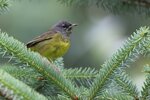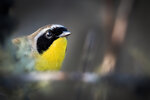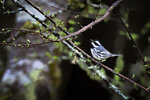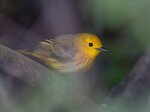



Sitting at my computer on a rainy day (good for gardens, but not for bird watching), I’m thinking about migrating warbler species that are arriving daily in our territory. These insect-eating species are returning to their breeding territory to take advantage of the insect feast that warm weather brings. They’re good singers and are sometimes identified primarily by their songs.
All warbler species respond to the generalized alarm call, “phsh, phsh,” or your version of it. The sound arouses their curiosity, and that might bring them closer, so you get a good look. Notice, if you can, the bird’s bill shape, its colors, from back to belly, the overall size and shape of the bird and its tail. Often, it will take seeing a bird more than once before you get its identity dialed into your memory. Birds are complicated.
Most warblers build a rough, bulky outer nest, maybe 5” across, made of leaves, bark, and other materials. Then, in the center of this, the female will construct a small (2”) cup-like nest lined with hair, feathers, and fine plant materials. Unfortunately, disguising the nest isn’t always successful. All warbler species are subject to nest predation by Brown Cowbirds, where the female cowbird adds an egg to the warbler nest. Sometimes, the parents end up raising a cowbird fledgling.
Here are the migrating warblers that I like to watch for:
Yellow Warbler – This is my favorite – when I hear this guy singing his sweet song, I know spring is well underway for the birds. The sexes of this species are alike (yellow head and chest, greenish back), except the males have chestnut streaks across the breast.
Females build nests in the forked tree branch and, if predated by a cowbird, will build a new nest layer on top of the old. These birds prefer deciduous trees in open areas near wetlands and streams. Singing males like to perch near the tops of trees and, therefore, are easy to spot. Look and listen for them along the Nisqually Refuge wetland boardwalks.
Black-throated Gray Warbler - This small warbler might be found in any wooded area in our county, especially if there is a brushy understory. They are insect eaters and often are seen hunting along the forest edge. Females build woven nests on horizontal branches, usually about head height. Singing males often can be spotted on open branches. There is no other common warbler in our area that has a black throat, gray back, and white striped breast. The sexes look alike.
Common Yellowthroat – These small warblers prefer brushy habitats where they hop around hunting insects, their main prey. They are often found near wetlands, but I have also found them nesting in “old growth” Scot’s Broom well away from water. The female builds a small woven nest on or near the ground in thick brush. Both sexes have a brownish back and yellow throat and breast. The males sport a bold black mask set off by a white stripe above. Males sing all day, off and on, with a song that sounds like “witchety, witchety, witch.”
Wilson’s Warbler – This is another small insect-eating warbler that will be arriving soon. The sexes are similar (overall yellow with greenish wings), but the males have a distinctive black cap. These birds prefer open woodland areas, perhaps with wetlands, where they forage along the branches of small alders and willows. They are never in dry areas or thick forests. Females build a nest at the base of a tree, first collecting leaves and bark, and then weaving a small cup-like nest that nestles into the leaf collection. Many warblers have complex songs, but the Wilson’s males do not. His song is a short series of loud, sweet notes.
McGillivray’s Warbler – This final migrating warbler is the most mysterious, at least for me, since although they’re fairly common I generally have no luck in locating them. Again, we have a small warbler; the males have a dark gray hood with an olive back and yellowish breast. The female is like the male but much duller. Both have white crescents above and below the eye (and, amazingly, these crescents show up easily with binoculars). These birds live in the thick brush that regrows after a disturbance in the woodlands. They are nearly always low in the underbrush. Their nest is built in this low brush, and males and females share in brooding and rearing young. They like to hide quietly, and their presence is often indicated only by the singing male proclaiming his territory.
These warblers are not exactly neighborhood birds, but by visiting parks, natural and/or wild/overgrown areas, especially near water, you are very likely to find one or more of them.
George Walter is the environmental program manager at the Nisqually Indian Tribe’s natural resources department; he also has a 40+ year interest in bird watching. He may be reached at george@theJOLTnews.com
Photos for this column are provided by Liam Hutcheson, a 16-year-old Olympia area birder and avid photographer.
4 comments on this item Please log in to comment by clicking here
rockyw98502
Photo for the Yellow Warbler looks an awful lot like the photo for the McGillivray's??
Friday, April 26 Report this
Georgewalter
Yellow warbler photo corrected.
Friday, April 26 Report this
marygentry
Fred & I both really enjoyed your article. Fred is having difficulty logging in so I am writing for both of us. We have had a lot of towhees lately. I still call them Rufus sided.
Mary $ Fred
Saturday, April 27 Report this
Terrilovesanimals
They are all SO cute! I have seen some and I loved learning about them! Thank you!
5 days ago Report this